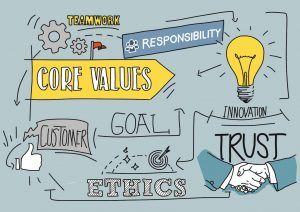0
You have 0 items in your cart

The collective set of beliefs, attitudes, and values shared by all employees in an organization constitute its culture. It is, therefore, an essential component and has a big impact on the strategic direction of the business. It directly affects management decisions, operations, and also every aspect of the business’ functions from production to accounting. This is because business culture relates to employee behavior, etiquette, and ethics.
It also includes the vision, mission, values, beliefs, and habits of the organization and its employees. This means that an organization with a good culture can be identified by how it conducts its meetings, negotiations, and other formal elements, use of its social media platforms to reach customers, internship and work placement programs, and other elements of its operation.
 A company’s or organization’s business culture can, therefore, be termed as its sole driving force. It determines how employees at different levels communicate as well as how customers and clients are treated. It has the potential to help the organization achieve its goals and objectives or have it struggling to remain operational.
A company’s or organization’s business culture can, therefore, be termed as its sole driving force. It determines how employees at different levels communicate as well as how customers and clients are treated. It has the potential to help the organization achieve its goals and objectives or have it struggling to remain operational.
While it takes some work to cultivate a good business culture in the workplace, the benefits far outweigh the hiccups and struggles endured to achieve it.

A good business culture has widespread benefits that are not only experienced in the workplace, but also to the end users of the product or service. One of the most obvious and most noticeable effects of a good business culture is usually in the performance of the organization as a whole. Cultures that are guided by strong visions and values are the perfect recipes for high-performance levels because they inspire employees to go the extra mile and also attract and retain talent in their respective fields.
 The Link Between Commitment and Culture Becomes Clearer
The Link Between Commitment and Culture Becomes Clearer People will be more committed to developing the cultural values that will help propel the company and ensure its longevity when there is a strong and positive culture in place. There will also be higher levels of internal cohesion, which will enable the organization to act as a whole in achieving its business objectives.
In terms of the consumers or end users, a good business culture will result in increased loyalty. People always want to be associated with a product or brand that has a working system and one that makes them feel valued. Therefore, an organization with a good culture that extends to its users will onboard more customers, many of whom will be through word of mouth, which is ultimately the best marketing strategy.
A great culture provides the context for people to deliver their best work
There are numerous ways that organizations can employ to ensure that the workplace has a good culture that will foster relationships and ensure optimum performance among its employees. Some methods are untested but logically sound while others have been proven scientifically to work. The right method to use solely depends on the business and the culture that it aims for. It, therefore, means that what works for one organization may not necessarily work for another. However, some universal methods are practical and can be used in any organization irrespective of size or objectives. Below we discuss eight of these methods that can help an organization achieve the right culture in its workplace.
 HR Process: Do You Hire Based on Attitude or Achievements?
HR Process: Do You Hire Based on Attitude or Achievements?
(HR)To improve the business culture, the first area that needs an overhaul is the HR recruitment process. For many organizations, educational qualifications are given precedence over other factors. While doing this guarantees an organization of having the best minds in their respective fields, the attitudes of these people are bound to be very different. Trying to get such groups of people to work toward a common goal will prove to be too time and resource consuming.
A better and more convenient approach for the organization is ensuring all new hires have similar attitudes and share common interests and values. This way, no effort is required to make the employees work toward a set or goals.
The core values of an organization are its guiding principles. They play a significant role in guiding the way people work and deciding the right or wrong way of working. In other words, core values are deeply held principles that help organizations in the decision-making processes. At the individual level, the core values assist in making important personal decisions and career choices.
Core values are important in any workplace because they set a tone for the organization’s culture. They support the organization’s vision and play the greatest role in shaping its business culture. To customers and the external world, core values give a clear picture of the organization’s principles – its philosophy, what it is about, and what is of greatest value to it. They clarify the identity of the organization. Because of this, it is important that employees align their values with those of the organization.
 Since the core values are so instrumental in shaping the identity of the organization, they need to be fixed. Factors including time, internal or external affairs, financial or political atmosphere, and any other factor that could affect the organization should not cause a change in the core values. With these in place, there will be increased internal understanding where everyone will work harder to do what is required of them, and great relationships will be fostered. Overall, the organization will be able to achieve its missions and objectives.
Since the core values are so instrumental in shaping the identity of the organization, they need to be fixed. Factors including time, internal or external affairs, financial or political atmosphere, and any other factor that could affect the organization should not cause a change in the core values. With these in place, there will be increased internal understanding where everyone will work harder to do what is required of them, and great relationships will be fostered. Overall, the organization will be able to achieve its missions and objectives.
Defining core values is usually not an easy task, but a visionary leader will know and understand the value of having them in place. Zappos, probably the most referenced company when it comes to defining the right core values.
The best steps to take are…

Identify pre-existing values in the workplace: This is easily achieved by having everyone chip in by suggesting what they feel is important to them and the organization.

Determine the right values for the workplace: From the feedback given, it is easy to pick values that closest represent the vision of the business.

Be ready to live by your values: This means that even during the hiring process, a candidate that does not share the same values with the organization should not be hired – irrespective of their qualifications. This way, values of the organization are not compromised.

Encourage growth and get rid of old measures of success: A company that encourages professional growth in their employees passes the message that it not only wants to benefit from its employee’s labor but is also concerned about their progress and future. Encouraging growth is necessary for an organization because it inspires more loyalty and commitment from the staff because they feel important and supported.
In the same breath, redefining measures of success in an organization brings new excitement into the workplace. Do the traditional measures entail looking at delivery times, project budgets, or delivery methods as the key measures of success? Defining new measures will have employees more excited about working towards their goals.
Methods that can be used to encourage growth within the organization are:

Giving employees the freedom to take an initiative: Giving employees the freedom to develop their own opportunities or allowing them to make mistakes and learn from them gives them a great learning and growth opportunity.

Giving employees the freedom to take an initiative: Giving employees the freedom to develop their own opportunities or allowing them to make mistakes and learn from them gives them a great learning and growth opportunity.

Allow employees to attend conferences and events: Industry conferences and events always provide employees excellent opportunities to learn new practices that can apply to their job. Given the constant evolution of industries and the way businesses move at fast paces, employees should be given every chance possible to stay abreast of these changes. This way, they will grow professionally and also gain the necessary tools to ensure they are always productive.
In most workplaces, the terms accountable and responsible are used interchangeably to mean the same thing. Practically, they have different meanings. For instance, when hiring, an employee is usually presented with a list of duties. It becomes their duty to ensure that the tasks are completed on time. These are their responsibilities.
 Accountability, on the other hand, is more about a person’s character. An accountable person will ensure that they have completed each task to the best of their abilities within the stipulated time. They not only ensure that they do the job but also take responsibility for the results, whether good or bad. An employee who is not accountable will place the blame on someone else when they fail at a responsibility or will do haphazard work just to get their paycheck. They will not put in effort or take pride in the work they do; the most they will do is what is expected of them.
Accountability, on the other hand, is more about a person’s character. An accountable person will ensure that they have completed each task to the best of their abilities within the stipulated time. They not only ensure that they do the job but also take responsibility for the results, whether good or bad. An employee who is not accountable will place the blame on someone else when they fail at a responsibility or will do haphazard work just to get their paycheck. They will not put in effort or take pride in the work they do; the most they will do is what is expected of them.

Make Accountability a Core Value: Making accountability a core value that every employee in the organization should strive for increases employee dedication to their work. The meaning of accountability should be universally agreed on so as to make it easier for every member in the organization work toward the same goal of making it an organizational value.

Guide People to Think Accountably: Not everyone in the workplace will be predisposed to being accountable. Therefore, for those who shun away from being accountable, guiding them to see how things would have been different is better and more effective than reproaching them.

Support and Encourage Staff to Not be Afraid of Being Accountable: Self-defense is the main reason employees avoid accountability. For example, an employee who has had bad experiences in the past, or one with a low self-esteem, will be fearful of accountability when they imagine the consequences when things go wrong. Helping build confidence in people by giving praise where due is a good way of increasing their accountability.

Specify what each employee is responsible for: When employees clearly understand what they are responsible for, they will ensure they are accountable for it. A good way of doing this is by using an RASCI Chart. This way, every task is broken down into levels of accountability and so reduces confusion and chances of a blame game when things go wrong.
Be Passionate about the culture and the business, and remain positive because it inspires others
Celebrate both success and setbacks — regardless of the size of the organization or what it does, celebrating victories and achievements is always a great way of cultivating the office culture. Doing this acts as a motivation and gives employees the reason to work harder and achieve something.
 Apart from celebrating the big wins, celebrating micro-wins is even more effective because these small wins are usually what leads to the big wins. Therefore, appreciating and acknowledging efforts that resulted in these small wins and successes sets the pace for the organization to achieve the big win.
Apart from celebrating the big wins, celebrating micro-wins is even more effective because these small wins are usually what leads to the big wins. Therefore, appreciating and acknowledging efforts that resulted in these small wins and successes sets the pace for the organization to achieve the big win.
On the flip side, not many companies celebrate setbacks. There is just no reason for doing so. However, setbacks can be used as excellent learning opportunities, and the lessons learned are worth celebrating. For instance, let us take an example of an organization that has been planning a major website campaign that experienced an unsuccessful launch. Typically, the team involved would be engrossed in politics of whose fault the failure was. Instead of this, healthy culture would have the team spending this energy understanding what went wrong and celebrating the lessons learned. This will prevent such a hiccup from happening again.
Another great way companies can improve the business culture is by allowing flexibility in the workplace. Research has proved that employers who give an increased level of flexibility to their staff enjoy much better returns in terms of employee output and revenue. However, the level and type of flexibility will depend on what works best for the organization.
 The three main ways flexibility can be incorporated into a workplace are job sharing, home office, and flex time. While it is possible for an organization to integrate multiple techniques, results yielded from each will vary. It is, therefore, better to find one or two that work best and use them. From surveys, it has been discovered that employees prefer working extended hours in a 4-day week than the typical 9-5 schedule. This way they are more satisfied with their jobs and are willing to go the extra mile to ensure the success of the organization.
The three main ways flexibility can be incorporated into a workplace are job sharing, home office, and flex time. While it is possible for an organization to integrate multiple techniques, results yielded from each will vary. It is, therefore, better to find one or two that work best and use them. From surveys, it has been discovered that employees prefer working extended hours in a 4-day week than the typical 9-5 schedule. This way they are more satisfied with their jobs and are willing to go the extra mile to ensure the success of the organization.
Allowing flexibility has a number of advantages that include:

Better Work-Life Balance: In many cases, this is the biggest reason employees want flexibility in the workplace. They can spend more time with their families and thus have a better balance between their work, social, and family lives. Job share and flextime are a great way of achieving this.

Increased Productivity: A flexible working schedule communicates to employees that they are trusted enough to be allowed to manage themselves more. This results in the employees wanting to impress and will go over and beyond what they are required to do.

Increased Employee Satisfaction: Flexible workplace conditions lead to more loyal employees who are less likely to leave the organization in search of greener pastures.
However, for flexibility to be successful, employees need to be more accountable and possess exceptional communication skills.
A person’s education is a critical identifier of whether they are qualified for the position they have applied for. Unfortunately, in most cases, this is as far as a company or organization’s interest in the education level of their employees goes. After employment, reference is rarely made to their educational achievement. In some cases, if required, an organization may set up training for their staff in order to improve their productivity. However, to foster a good culture within an organization, it is paramount that investment is made in terms of employee training and education.
The unfortunate scenario in many organizations is where employers shun away from supporting educational ventures for their employees because, in most cases, this is not termed as a wise or worthy investment for the organization.
 Taking an example of HubSpot, investing in their employees has proved to pay off for the company. The management of HubSpot believes that an employee exploring their passions in the form of furthering their studies works to liven the company and make it more vibrant and effective. The company takes an interest in bolstering employee skills, especially those that are important to their professional development through offering training to employees.
Taking an example of HubSpot, investing in their employees has proved to pay off for the company. The management of HubSpot believes that an employee exploring their passions in the form of furthering their studies works to liven the company and make it more vibrant and effective. The company takes an interest in bolstering employee skills, especially those that are important to their professional development through offering training to employees.
Additionally, when an employee has an interest in furthering their studies, the company chips in financially to support the employee. Such a move goes a long way in making an employee feel appreciated and valued. They will, as a result, be more diligent in their work and also be more loyal to the organization. Overall, the business culture will be greatly boosted.

Cultural entropy is the measure of dysfunction in a workplace. Dysfunction is the biggest setback when trying to achieve a good business culture. Iresults in a lot of energy being consumed in doing unnecessary and unproductive activities. Workplaces with high cultural entropy levels usually experience heightened levels of blame, manipulation, corruption, and internal competition among employees. As such, it is imperative that the management device ways of minimizing it.
Healthy cultural entropy levels for an organization should be below 10%, and thus, this is what should be the aim. Entropy levels of above 30% portray an unhealthy workplace atmosphere that requires immediate action.
One of the best and most effective ways of minimizing an organization’s cultural entropy is by living its core values. As discussed above, the core values of an organization are its guiding principles and will, therefore, enable the business to achieve the desired cohesion within its workforce. The best culture is nurtured with values of accountability, integrity, compassion, and respect being among the organization’s core values.
This Privacy Policy describes how SmartMinds Enterprise OÜ (“SmartMinds”, “we”, “us” or “our”) handles information about yourself that you may provide us with through your use of the Site or Service (“Personal Information”) and should be read along with our Terms of Use posted here, and all other operating rules and additional terms and conditions published on our Site.
SmartMinds is committed to keeping your information secure and managing it in accordance with our legal responsibilities under privacy and data protection laws where we operate. SmartMinds uses your Personal Information only in accordance with this Privacy Policy and Applicable Law. SmartMinds does not sell your Personal Information to third parties. Any capitalized terms not defined in this Privacy Policy are defined in the Terms of Use.
We employ the use of cookies. By using SmartMinds‘s website you consent to the use of cookies in accordance with SmartMinds’s privacy policy.
Most of the modern day interactive web sites use cookies to enable us to retrieve user details for each visit. Cookies are used in some areas of our site to enable the functionality of this area and ease of use for those people visiting. Some of our affiliate / advertising partners may also use cookies.
Unless otherwise stated, SmartMinds and/or it’s licensors own the intellectual property rights for all material on SmartMinds All intellectual property rights are reserved. You may view and/or print pages from https://smartminds.one for your own personal use subject to restrictions set in these terms and conditions.
You must not:
We will approve link requests from these organisations if we determine that: (a) the link would not reflect unfavourably on us or our accredited businesses (for example, trade associations or other organisations representing inherently suspect types of business, such as work-at-home opportunities, shall not be allowed to link); (b)the organisation does not have an unsatisfactory record with us; (c) the benefit to us from the visibility associated with the hyperlink outweighs the absence of SmartMinds; and (d) where the link is in the context of general resource information or is otherwise consistent with editorial content in a newsletter or similar product furthering the mission of the organisation.
These organisations may link to our home page, to publications or to other Web site information so long as the link: (a) is not in any way misleading; (b) does not falsely imply sponsorship, endorsement or approval of the linking party and its products or services; and (c) fits within the context of the linking party’s site.
If you are among the organizations listed in paragraph 2 above and are interested in linking to our website, you must notify us by sending an e-mail to Please include your name, your organisation name, contact information (such as a phone number and/or e-mail address) as well as the URL of your site, a list of any URLs from which you intend to link to our Web site, and a list of the URL(s) on our site to which you would like to link. Allow 2-3 weeks for a response.
Approved organizations may hyperlink to our Web site as follows:
No use of (name)’s logo or other artwork will be allowed for linking absent a trademark license agreement.
Without prior approval and express written permission, you may not create frames around our Web pages or use other techniques that alter in any way the visual presentation or appearance of our Web site.
We shall have no responsibility or liability for any content appearing on your Web site. You agree to indemnify and defend us against all claims arising out of or based upon your Website. No link(s) may appear on any page on your Web site or within any context containing content or materials that may be interpreted as libelous, obscene or criminal, or which infringes, otherwise violates, or advocates the infringement or other violation of, any third party rights.
We reserve the right at any time and in its sole discretion to request that you remove all links or any particular link to our Web site. You agree to immediately remove all links to our Web site upon such request. We also reserve the right to amend these terms and conditions and its linking policy at any time. By continuing to link to our Web site, you agree to be bound to and abide by these linking terms and conditions.
If you find any link on our Web site or any linked web site objectionable for any reason, you may contact us about this. We will consider requests to remove links but will have no obligation to do so or to respond directly to you.
Whilst we endeavour to ensure that the information on this website is correct, we do not warrant its completeness or accuracy; nor do we commit to ensuring that the website remains available or that the material on the website is kept up to date.
We have a 30-day Money Back Guarantee when purchasing Realized Mind, all we ask if that within the 30 days to complete the learning experience and if you truly feel you did not receive any value from the experience we are happy to refund your payment and close your account.
To the maximum extent permitted by applicable law, we exclude all representations, warranties and conditions relating to our website and the use of this website (including, without limitation, any warranties implied by law in respect of satisfactory quality, fitness for purpose and/or the use of reasonable care and skill). Nothing in this disclaimer will:
The limitations and exclusions of liability set out in this Section and elsewhere in this disclaimer: (a) are subject to the preceding paragraph; and (b) govern all liabilities arising under the disclaimer or in relation to the subject matter of this disclaimer, including liabilities arising in contract, in tort (including negligence) and for breach of statutory duty.
To the extent that the website and the information and services on the website are provided free of charge, we will not be liable for any loss or damage of any nature.
